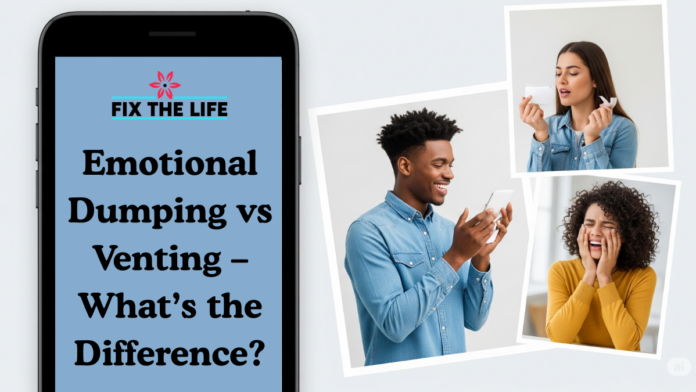We all experience frustration, sadness, or stress at times, and sharing those emotions with others can help us process them. However, there is a fine line between healthy venting and emotional dumping—one fosters connection, while the other can drain and overwhelm those on the receiving end.
Understanding the differences between emotional dumping vs venting is essential for healthy communication and ensuring that relationships remain supportive rather than emotionally taxing.
What Is Venting? A Healthy Way to Express Emotions
Venting is a natural and healthy way to express emotions in a balanced way. It allows individuals to release stress, gain perspective, and receive emotional support without overwhelming the listener.
Characteristics of Healthy Venting:
- Intentional and Controlled Expression: The person sharing is mindful of how much they unload.
- Reciprocal Emotional Support: The conversation allows both people to feel engaged.
- Open to Solutions or Perspective: The individual venting seeks clarity or comfort.
- Respects Boundaries: Venting does not overwhelm or emotionally exhaust the listener.
Example: After a tough day at work, someone might say, “I had a really frustrating meeting today. Can I vent for a few minutes?”
In this scenario, the person is seeking relief but also respecting the listener’s space.
What Is Emotional Dumping? When Venting Becomes Harmful
Emotional dumping happens when someone offloads excessive emotional distress without considering the impact on the listener. Unlike venting, which is structured and mindful, dumping is unfiltered and overwhelming, often leaving the recipient drained.
Signs of Emotional Dumping:
- Constant Unloading Without Pause: The speaker overwhelms the listener with negativity.
- Disregards Emotional Boundaries: The conversation feels one-sided and emotionally exhausting.
- Rejects Advice or Support: The speaker unloads but does not seek solutions.
- Creates Emotional Burden for the Listener: The listener may feel used rather than engaged.
Example: Someone repeatedly texts a friend at midnight, venting about personal issues without considering if the friend is available or emotionally capable of handling it.
Emotional dumping shifts the burden of emotional regulation onto the listener, often leaving them emotionally drained.
Emotional Dumping vs Venting: Key Differences
| Aspect | Venting | Emotional Dumping |
|---|---|---|
| Emotional Awareness | Mindful of the listener’s time and energy | Unfiltered and overwhelming |
| Purpose | Seeks support, clarity, or comfort | Releases distress without seeking solutions |
| Boundaries | Respects the listener’s emotional space | Ignores whether the listener is available |
| Reciprocity | Allows for mutual exchange in conversation | One-sided unloading of negativity |
| Impact on Listener | Feels heard and supported | Feels drained, pressured, or emotionally burdened |
Recognizing these differences helps maintain healthier connections in relationships.
How to Vent Without Emotionally Dumping
If you struggle with managing emotions and need to express them effectively, consider these strategies:
1. Ask Before Unloading
Before venting, check in with the listener:
- “I need to talk about something—do you have space for that right now?” This shows respect for their emotional capacity.
2. Keep the Conversation Balanced
Venting should allow room for feedback and engagement rather than just unloading frustration.
3. Limit Excessive Negative Talk
Repeating complaints without solution-seeking creates emotional exhaustion. Instead, focus on productive conversation.
4. Set Boundaries With Yourself
Ask:
- “Am I venting for clarity, or am I expecting the listener to absorb all my frustration?” This helps regulate emotional unloading.
5. Seek Professional Support When Necessary
If emotions feel too overwhelming, consider therapy for deeper emotional processing instead of relying solely on friends.
How to Handle Emotional Dumping From Others
If someone consistently dumps emotions onto you, here’s how to set boundaries:
1. Recognize Your Limits
If conversations leave you emotionally drained, take note of how often this happens.
2. Set Boundaries Clearly
Say: “I care about you, but I can’t absorb so much negativity right now. Can we talk about solutions instead?”
3. Encourage Healthy Emotional Outlets
Suggest alternatives like journaling, therapy, or mindfulness practices.
4. Distance Yourself When Necessary
If someone repeatedly ignores boundaries, stepping back from frequent interactions may be necessary for emotional protection.
FAQs
Q1: Is venting always healthy?
Venting is healthy when done in moderation, with respect for boundaries. Excessive venting can turn into dumping.
Q2: How can I tell if I’m emotionally dumping?
If you constantly unload emotions without considering the listener’s well-being, refuse feedback, or dominate conversations with negativity, it may be emotional dumping.
Q3: How do I stop someone from emotionally dumping on me?
Communicate boundaries directly, suggesting healthier ways to manage emotions while protecting your own mental space.
Q4: Should I seek professional help if I emotionally dump often?
If emotions feel overwhelming and impact relationships, seeking therapy can provide structured emotional management strategies.
Q5: How can I vent in a healthy way?
Practice mindful expression, set boundaries, engage in reciprocal conversation, and balance venting with solution-seeking.
Final Thought
Understanding emotional dumping vs venting helps maintain healthy communication and emotional support in relationships. Expressing emotions is natural, but balancing self-awareness with respect for others’ emotional space ensures meaningful connections without creating unnecessary burden.




